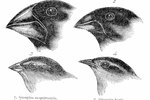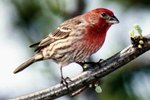
Called chickadees -- after the sound they make -- or titmice, these active and popular birds belong to the genus Poecile. Sometimes called tits, seven kinds of chickadee songbirds call North America home. All chickadees have characteristic dark head caps and bibs with white cheeks. Black-capped and Carolina chickadees prove difficult to distinguish from each other, but the boreal, chestnut-backed, gray-headed, mountain and Mexican chickadees have distinguishing characteristics. When habitats overlap, inter-species breeding may be apparent, which can complicate breed identification.
Black-Capped Chickadee
Black-capped chickadees inhabit a wide range of habitats from Alaska, through Canada and into the northern United States. These birds prefer mature forests with dense woods to shelter their nests. They will migrate to warmer locations in the winter and combine with titmice, woodpeckers and other small birds to form larger mixed species flocks. These small 4.5- to 5-inch birds have a head striped black and white, black bib on throat with white below and black stripes on sides, as well as a gray back with black striping, two white wing bars and white outer tail feathers.
Carolina Chickadee
Carolina chickadees look a lot like black-capped chickadees. Their forest habitat overlaps the habitat of black-capped chickadees through the central U.S. and includes the southern U.S. east of the Rocky Mountains. Carolina chickadees do not have white wing edgings or gray on their flanks. In overlapping territory like the Appalachian Mountains, the Carolina chickadee will live at lower elevations, while the black-capped chickadee prefers greater heights. Also, the Carolina chickadee has a faster, higher-pitched call than its black-capped cousin.
Boreal Chickadee
The boreal chickadee lives in northern forest regions, preferring to nest in spruce and fir trees. This hardy little bird has a black chin, brown cap and brownish sides. It can be found in Alaska and throughout Canada. Sometimes, it lives in the northern edge of the United States at elevations supporting boreal forests. Boreal forests have long winters and fairly high annual precipitation.
Mountain Chickadee
Mountain chickadees live in mixed-forest mountainous regions of the West from interior British Columbia south through Rocky Mountain and Cascade-Sierra mountain chains to southern California and western Texas. Seldom do they live in regions below 3,000 feet. The mountain chickadee is distinguished from other chickadees by its white eye stripe, gray flank and gray under-tail feathers. Also, its voice is a bit lower pitched with a huskiness to it.
Chestnut-Backed Chickadee
The chestnut-backed chickadee lives in the pacific rainforests along the coasts of Alaska, Canada and the U.S. They have brown flanks and backs with a black cap and bib. This chickadee is found in edge habitats near forests and streams, as well as fully forested areas. Chestnut-backed chickadees have the highest and fastest calls of the chickadee species.
Mexican Chickadee
In the United States, the Mexican chickadee can only be found in the southern mountains of Arizona and New Mexico. In Mexico, this chickadee can be found throughout the mountain forests. The top of the head and entire chin, throat and chest region of this bird is deep black. The rest of the bird is olive-gray and white.
Gray-Headed Chickadee
The gray-headed chickadee has a gray-brown cap, white cheeks and a black bib. The flanks are buff-colored. Once known as the Siberian tit, these chickadees appear to be a bit more fluffy and robust than other North American chickadees. Gray-headed chickadees are considered sub-arctic and live in Alaska and western Canada.
References
- Cornell Laboratory of Ornithology, Birdscope: Distinguishing Chickadees
- The Pennsylvania University: The Virtual Nature Trail at Penn State New Kensington, Black-Capped Chickadee
- National Audubon Society, Birds: Black-Capped Chickadee
- National Geographic: Carolina Chickadee
- National Park Service, United States Department of the Interior: Bird Species and Distributions in the Yukon-Charley Rivers National Preserve, Boreal Chickadee
- National Audubon Society, Birds: Mountain Chickadee
- National Audubon Society, Birds: Chestnut-Backed Chickadee
- National Audubon Society, Birds: Mexican Chickadee
- National Audubon Society, Birds: Gray-Headed Chickadee
Photo Credits
-
Jupiterimages/Photos.com/Getty Images
Writer Bio
Based in Michigan, Keri Gardner has been writing scientific journal articles since 1998. Her articles have appeared in such journals as "Disability and Rehabilitation" and "Journal of Orthopaedic Research." She holds a Master of Science in comparative medicine and integrative biology from Michigan State University.




